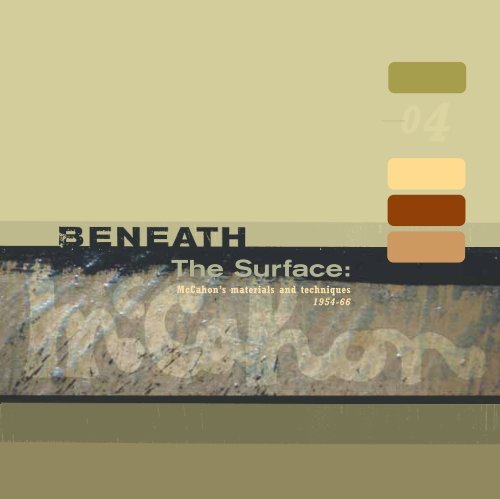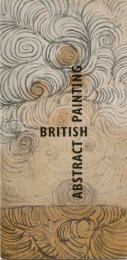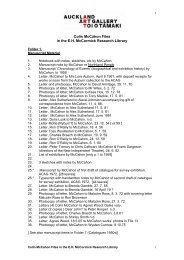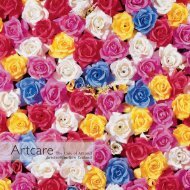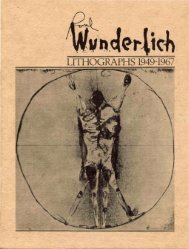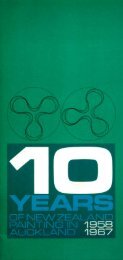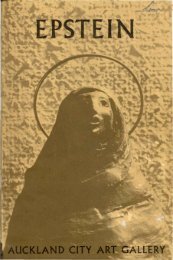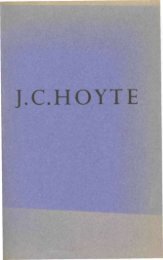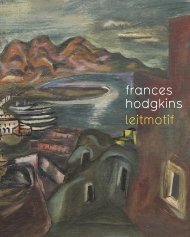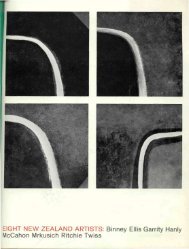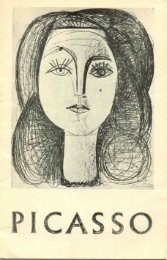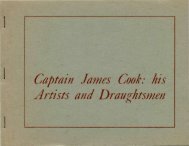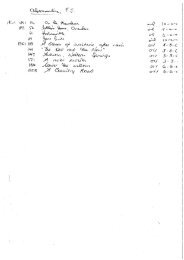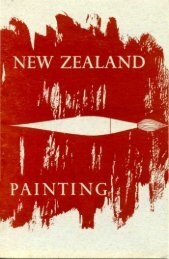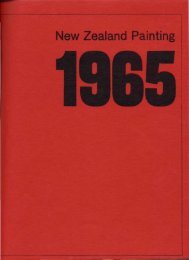Beneath the Surface: McCahon's materials and techniques 1954-1966
Beneath the Surface: McCahon's materials and techniques 1954-1966
Beneath the Surface: McCahon's materials and techniques 1954-1966
You also want an ePaper? Increase the reach of your titles
YUMPU automatically turns print PDFs into web optimized ePapers that Google loves.
The <strong>Surface</strong>:<br />
McCahon’s <strong>materials</strong> <strong>and</strong> <strong>techniques</strong><br />
<strong>1954</strong>-66<br />
04
I <strong>and</strong> Thou <strong>1954</strong>-55<br />
oil on hardboard 558 x 538mm<br />
Colin McCahon<br />
N.Z Woman’s Weekly Photograph 27.3.1961<br />
Will he save him? 1959<br />
Alkyd <strong>and</strong> natural resin on hardboard 1227 x 910mm<br />
Easter L<strong>and</strong>scape: Triptych <strong>1966</strong><br />
PVA on hardboard panels, each panel 1802 x 594 x 20mm
The <strong>Surface</strong>: McCahon’s <strong>materials</strong> <strong>and</strong> <strong>techniques</strong> <strong>1954</strong>-66<br />
There has been much debate about Colin McCahon’s art, but an area which remains largely<br />
unexplored is <strong>the</strong> artist’s use of non-traditional painting <strong>materials</strong>. <strong>Beneath</strong> <strong>the</strong> <strong>Surface</strong>, an<br />
exhibition resulting from four years of research into this subject by Auckl<strong>and</strong> Art Gallery’s<br />
Principal Conservator, Sarah Hillary, helps to redress <strong>the</strong> balance. The exhibition presents<br />
in-depth analysis of three significant paintings from <strong>1954</strong>-66, when <strong>the</strong> artist often experimented<br />
with household paints.<br />
Dulux Enamel, Giant Monocoat, Taubman’s Butex <strong>and</strong> Solpah – <strong>the</strong><br />
types of commercial paints used by McCahon during <strong>the</strong> 1950s <strong>and</strong><br />
60s read like a h<strong>and</strong>yman’s shopping list for a visit to <strong>the</strong> hardware<br />
store. These <strong>and</strong> o<strong>the</strong>r new paints, which came onto <strong>the</strong> New Zeal<strong>and</strong><br />
home decorator’s market in <strong>the</strong> 1950s, were adapted to fine art<br />
purposes by McCahon <strong>and</strong> o<strong>the</strong>r artists who had become accustomed<br />
to improvising during World War II. In a period when artist-quality<br />
<strong>materials</strong> were in short supply, artists had been forced to make up <strong>the</strong>ir own<br />
paints, or use housepaints as a cheap <strong>and</strong> readily available alternative.<br />
Artists such as McCahon also experimented with<br />
commercial paints as a means of exploring <strong>the</strong> visual<br />
results made possible by <strong>the</strong> distinct properties of <strong>the</strong>se<br />
<strong>materials</strong>. Scientific innovation in paint manufacture had<br />
made it conceivable to break with old methodology.<br />
In general, <strong>the</strong> new paints produced glossier, flatter<br />
surfaces, more intense colours <strong>and</strong> dried much faster<br />
than conventional oil paint. Because <strong>the</strong>y were less<br />
expensive, experimentation on a large scale did not carry<br />
<strong>the</strong> same financial risk as working up a potentially<br />
unsuccessful composition in artist-quality oil. McCahon<br />
often painted on hardboard for similar reasons, buying<br />
large pre-cut pieces, which according to Richard Killeen,<br />
he would line up on <strong>the</strong> floor of <strong>the</strong> studio <strong>and</strong> “whack<br />
<strong>the</strong>m out, do <strong>the</strong>m all fast” i . The free-flowing properties of<br />
housepaints facilitated this spontaneous approach <strong>and</strong><br />
enabled McCahon to produce a large number of related<br />
compositions in a relatively short timeframe, such as <strong>the</strong><br />
Elias series of 1959. The combination of commercial<br />
paints <strong>and</strong> hardboard also allowed him to achieve very<br />
smooth painted surfaces, which he occasionally<br />
enlivened by applying s<strong>and</strong> <strong>and</strong> sawdust.<br />
Figure<br />
01<br />
Figure<br />
03<br />
Figure<br />
04<br />
Figure<br />
02<br />
McCahon’s works of this period attracted controversy for <strong>the</strong> artist’s<br />
deployment of unorthodox media, as well as <strong>the</strong> highly personal<br />
iconography of <strong>the</strong> images. In 1962 for instance, R.H. Stillwell of<br />
<strong>the</strong> Robert McDougall Art Gallery objected to displaying <strong>the</strong> painting<br />
Tomorrow will be <strong>the</strong> same but not as this is, which he labelled a<br />
“monstrosity”, partly because of <strong>the</strong> dark imagery <strong>and</strong> partly because it<br />
was on hardboard instead of canvas. “It might get <strong>the</strong> borer” was <strong>the</strong><br />
complaint. ii An anonymous writer to <strong>the</strong> editor of The Press in <strong>the</strong> same<br />
year declared that ‘Colin McCahon has overdone it. His high-gloss<br />
“Gate Series” would make a delightful decoration in <strong>the</strong> right room, in<br />
an ultra-modern house, but <strong>the</strong>y have about as much “great message<br />
<strong>and</strong> tragedy” as my wardrobe door, which is also painted in high-gloss. ’ iii<br />
McCahon’s use of non-traditional <strong>materials</strong> <strong>and</strong> methods could be considered as part <strong>and</strong> parcel of a renegade nature,<br />
bolstering <strong>the</strong> myth that McCahon was an intentional nonconformist, an anti-academic painter. Yet no artist operates in a<br />
vacuum. A counterpart for McCahon’s experimentation with housepaints <strong>and</strong> o<strong>the</strong>r commercial products existed across <strong>the</strong><br />
Tasman in a circle of artists which included Sidney Nolan, Ian Fairwea<strong>the</strong>r, George Johnson, Leonard French <strong>and</strong> o<strong>the</strong>rs.<br />
The Masonite <strong>and</strong> Dulux brigade, <strong>the</strong>se artists similarly subscribed to <strong>the</strong> antipodean make-do ethic <strong>and</strong> even mocked<br />
painters who insisted on using proper artists’ <strong>materials</strong>. iv They treated technical innovation ‘as a challenge worthy of an artist’ v<br />
<strong>and</strong> believed that ‘To break free from conventional painting methods <strong>and</strong> to invent or adapt one’s own, signified an escape<br />
from earlier traditions’ vi .<br />
Fur<strong>the</strong>r afield, artists in America had been experimenting with commercial<br />
paints since <strong>the</strong> 1930s. Having used car paints for his exterior murals to<br />
increase <strong>the</strong>ir durability, David Alfaro Siqueiros ran workshops to share<br />
his discoveries with o<strong>the</strong>r artists. Jackson Pollock relied on industrial <strong>and</strong><br />
household paints, which were thin <strong>and</strong> easily poured, for his now famous<br />
drip technique. In Europe, as far back as 1912, Picasso used trade<br />
<strong>materials</strong> in combination with artists’ paints, <strong>and</strong> his attachment to<br />
Ripolin, a shiny, nitro-cellulose house paint, was influential on many<br />
artists. The significance of modern paints in <strong>the</strong> global evolution of<br />
creative expression was <strong>the</strong>refore something that McCahon would have<br />
certainly been aware of. A sojourn in Melbourne in 1951 <strong>and</strong> a four<br />
month tour of American galleries in 1958 would have increased this<br />
awareness of technical <strong>and</strong> stylistic developments abroad <strong>and</strong> reinforced his<br />
willingness to experiment. As Tony Green has observed ‘Look at America<br />
as confirmation for him – an assurance that what he was doing was not<br />
a willful error . . . McCahon was no beginner finding his way.’ vii
The paintings featured in <strong>Beneath</strong> <strong>the</strong> <strong>Surface</strong> exemplify McCahon’s use of three distinct forms of paint<br />
– oil, alkyd, <strong>and</strong> PVA. Oil is representative of a more traditional approach compared to enamel <strong>and</strong> PVA,<br />
which were examples of new syn<strong>the</strong>tic paints. Not only do <strong>the</strong>se paint types each have different binders,<br />
but often different pigments <strong>and</strong> additives as well. Interestingly, <strong>the</strong> media of all three works has previously<br />
been inadequately described in exhibition catalogues. A lack of underst<strong>and</strong>ing about <strong>the</strong> composition of<br />
<strong>the</strong> paints is partially to blame for this, although McCahon tended to name only <strong>the</strong> major constituent he<br />
had used in any one work.<br />
I <strong>and</strong> Thou, <strong>the</strong> earliest of <strong>the</strong>se paintings <strong>and</strong> one of McCahon’s first<br />
word paintings, was painted in <strong>1954</strong>-55, on hardboard. Although <strong>the</strong><br />
medium is described as oil in <strong>the</strong> Colin McCahon / a survey exhibition<br />
catalogue of 1972, analysis of a paint sample also identified some alkyd<br />
resin. Alkyd housepaints became available in New Zeal<strong>and</strong> in <strong>the</strong><br />
1950s <strong>and</strong> were commonly known as enamel because of <strong>the</strong>ir glossy<br />
appearance. The smooth surface in parts of <strong>the</strong> painting suggests <strong>the</strong><br />
presence of alkyd, which contrasts sharply with <strong>the</strong> impasto in <strong>the</strong> areas<br />
of oil (fig 1). Evidence of McCahon’s preference for short-hair brushes<br />
worn almost to <strong>the</strong> base can be seen in <strong>the</strong> shading of forms where<br />
<strong>the</strong>re is a dry scratching of colour. This technique is useful when<br />
painting with alkyd as <strong>the</strong> paint dries too rapidly to blend <strong>the</strong> colours<br />
on <strong>the</strong> surface.<br />
Painted almost five years later, also on hardboard, Will he save him? 1959, is one of more than<br />
one hundred Elias paintings produced in <strong>the</strong> period immediately following McCahon’s American<br />
sojourn. These works explore <strong>the</strong> spiritual fears <strong>and</strong> doubts of humankind, using as a vehicle <strong>the</strong><br />
Gospel incident in which Elias is petitioned to save Christ from crucifixion. In each composition,<br />
phrases from <strong>the</strong> biblical text are <strong>the</strong> predominant motifs, <strong>the</strong> words painted in a loose calligraphic<br />
style. These represent a distinct shift in McCahon’s technique directly related to his use of household<br />
paints. The free-flowing quality of alkyd or enamel paints enabled him to significantly modify<br />
his approach to text images, simply because he could ‘write’ with <strong>the</strong> paintbrush more freely. This<br />
contrast is well-evidenced by a visual comparison of Will he save him? <strong>and</strong> <strong>the</strong> earlier I <strong>and</strong> Thou.<br />
The drips of paint, bright colour <strong>and</strong> glossy surface of Will he save him? are characteristic of alkyd paints, <strong>the</strong> presence<br />
of which was confirmed by scientific analysis (fig 2). Although Taubman’s Solpah is <strong>the</strong> medium named on <strong>the</strong> reverse<br />
of <strong>the</strong> painting, alkyd <strong>and</strong> oil paint appear to have been added to this oleo-resinous paving paint. This suggests that<br />
as with I <strong>and</strong> Thou, McCahon mixed his paint types toge<strong>the</strong>r to achieve <strong>the</strong> desired effect. Paint cross-sections have<br />
revealed numerous layers of paint, indicating that artist made rapid reworkings <strong>and</strong> adjustments (fig 3). Light coloured<br />
surface layers mute darker colours below <strong>and</strong> dark forms emerge <strong>and</strong> submerge. There is a play between upper <strong>and</strong><br />
lower layers, highlighting <strong>and</strong> softening. McCahon’s frequent use of localised varnishing during this period is typified<br />
by this painting. A cross-section seen under ultra-violet light revealed highly fluorescent varnish layers (fig 4).<br />
Figure<br />
05<br />
Figure<br />
08<br />
Figure<br />
06<br />
Figure<br />
07<br />
The latest of <strong>the</strong> three works, Easter L<strong>and</strong>scape: Triptych <strong>1966</strong>, is painted on three hardboard<br />
doors, allowing <strong>the</strong>m to be hung without framing. The paint medium has been recorded as acrylic<br />
in <strong>the</strong> 1972 catalogue, but analysis of a paint sample detected PVA, which was manufactured in<br />
New Zeal<strong>and</strong> from <strong>the</strong> late 1950s. It is possible that McCahon did apply some acrylic in <strong>the</strong> painting,<br />
or o<strong>the</strong>rwise employed <strong>the</strong> term in a generic sense. Because of <strong>the</strong> flattening characteristics of<br />
housepaints, his use of impasto or <strong>the</strong> texturing of paint was extremely limited. Subtle textures<br />
could be produced by <strong>the</strong> building up of underpaint showing through to <strong>the</strong> surface (a technique<br />
frequently practiced by <strong>the</strong> artist), yet more dramatic results required <strong>the</strong> addition of textural <strong>materials</strong>.<br />
McCahon experimented with s<strong>and</strong> in paintings in <strong>the</strong> late 1950s, <strong>the</strong>n changed to sawdust in <strong>the</strong><br />
60s because it was easier to h<strong>and</strong>le <strong>and</strong> was available in a variety of coarsenesses. The surface<br />
of Easter L<strong>and</strong>scape: Triptych is predominantly opaque <strong>and</strong> glossy with <strong>the</strong> characteristic rounded<br />
texture associated with latex paints (fig 5). However, <strong>the</strong> inclusion of sawdust in <strong>the</strong> black areas<br />
works to catch <strong>the</strong> light at certain points, animating <strong>the</strong> surface of <strong>the</strong> image. As <strong>the</strong> viewer moves<br />
past <strong>the</strong> painting, light flickers across <strong>the</strong>se irregular, glossy black forms, creating <strong>the</strong> effect, in <strong>the</strong><br />
words of Buster Pihama, of a l<strong>and</strong>scape that is ‘jumping’. viii (fig 6).<br />
Varnish is present on <strong>the</strong> surface of Easter L<strong>and</strong>scape: Triptych <strong>and</strong> ultra-violet examination of<br />
a cross-section revealed a varnish layer between <strong>the</strong> black layers of paint which is not visible<br />
under normal light (figs 7&8). McCahon’s intention in applying varnish at this point is unclear,<br />
although he may have been trying to saturate <strong>the</strong> colours to reconsider <strong>the</strong> image during <strong>the</strong><br />
painting process. William McCahon remembers that his fa<strong>the</strong>r was well aware of how <strong>the</strong><br />
colour of <strong>the</strong> varnish could be used to suit his purposes. ix Unlike <strong>the</strong> layered effect of Will he<br />
save him?, it is not possible to see underlying colours coming to <strong>the</strong> surface in Easter<br />
L<strong>and</strong>scape: Triptych - PVA paint is much thicker than <strong>the</strong> alkyd <strong>and</strong> often quite opaque, <strong>the</strong>refore<br />
<strong>the</strong> emphasis is on relationships between forms <strong>and</strong> <strong>the</strong> movement of light on <strong>the</strong> surface of<br />
<strong>the</strong> composition.<br />
Ironically, an examination of <strong>the</strong> structure beneath <strong>the</strong> surface of McCahon’s paintings encourages us<br />
to re-focus on <strong>the</strong> surface. The use of underpaint, sawdust or s<strong>and</strong>, diverse brushwork <strong>and</strong> localised<br />
varnish all contribute to <strong>the</strong> delicate surface effects that are vital to <strong>the</strong> artistic concept behind all three<br />
images. McCahon’s choice of painting support - whe<strong>the</strong>r textured, flat, rigid, or ‘a bit curly at <strong>the</strong> edges’ x -<br />
also contributes significantly to <strong>the</strong> character of <strong>the</strong> surface.<br />
As each painting ages <strong>the</strong>re will be inevitable changes in its appearance <strong>and</strong> relationships will slightly<br />
shift. In order to respect <strong>the</strong> au<strong>the</strong>nticity of <strong>the</strong> artwork many of <strong>the</strong>se changes must be accepted as<br />
part of <strong>the</strong> natural ageing process. While contrary to popular belief, McCahon’s paintings have<br />
remained in good condition in <strong>the</strong> majority of instances, regrettably, inappropriate h<strong>and</strong>ling, conservation<br />
treatments <strong>and</strong> framing have caused permanent damage to some of <strong>the</strong>m. It is hoped however,<br />
that with a greater underst<strong>and</strong>ing of McCahon’s <strong>materials</strong> <strong>and</strong> <strong>techniques</strong>, this type of unnecessary<br />
damage can be avoided in <strong>the</strong> future.<br />
i Quoted in Agnes Wood, Colin<br />
McCahon: <strong>the</strong> man <strong>and</strong> <strong>the</strong> teacher,<br />
David Ling Publishing Ltd.,<br />
Auckl<strong>and</strong>, 1997, p.106<br />
ii The Christchurch Star, 18<br />
December, 1962<br />
iii The Press, 22 September, 1962<br />
iv Jenny Zimmer, ‘Memories of<br />
‘Masonite’ <strong>and</strong> ‘Dulux’: A Study of<br />
Experimental Painting Techniques<br />
used by Australian Modernists of<br />
<strong>the</strong> 1950s <strong>and</strong> 1960s’, The<br />
Articulate <strong>Surface</strong>, The Humanities<br />
Research Centre Monograph Series<br />
No. 10, The Australian National<br />
University <strong>and</strong> <strong>the</strong> National Gallery<br />
of Australia, Canberra, 1996, p.144.<br />
v ibid., p.147<br />
vi ibid., p.148<br />
vii Anthony Green, ‘McCahon’s Visit<br />
to <strong>the</strong> United States’, Bulletin of<br />
New Zeal<strong>and</strong> Art History, Vol. 3,<br />
1975, p.25.<br />
viii Sarah Hillary conversation with<br />
Buster Pihama, ex-pupil <strong>and</strong> friend<br />
of <strong>the</strong> artist, 30 April, 1998<br />
ix Sarah Hillary interview with<br />
William McCahon, 26 February,<br />
1998<br />
x Colin McCahon / a survey exhibition,<br />
exhibition catalogue, Auckl<strong>and</strong><br />
City Art Gallery, March/ April, 1972,<br />
p.48<br />
This project would not have been<br />
possible without <strong>the</strong> support<br />
of New Zeal<strong>and</strong> Lotteries Board<br />
Te Puna Tahua. In addition we<br />
would like to thank Tom Learner,<br />
Conservation Scientist, Tate<br />
Gallery, who carried out <strong>the</strong> media<br />
analysis of paint samples. This is<br />
<strong>the</strong> first time that McCahon’s<br />
painting media has been analysed<br />
to such a degree <strong>and</strong> <strong>the</strong> results<br />
have been invaluable.<br />
Sarah Hillary <strong>and</strong> Kendrah Morgan
Acrylic paints<br />
Alkyd paints<br />
Cross-sections<br />
Household paints<br />
Hardboard<br />
Masonite<br />
GLOSSARY<br />
Acrylics are polymers of acrylic acids <strong>and</strong><br />
<strong>the</strong>ir esters. Polymers are large molecules<br />
made up of many relatively simple repeated<br />
units. Acrylics <strong>and</strong> PVA paints used by<br />
McCahon were polymer emulsion systems,<br />
which are dispersions of solid or semi-solid<br />
polymeric particles in a continuous aqueous<br />
phase.<br />
Paints made from oil modified resins. The<br />
resultant mixture is very viscous <strong>and</strong> requires<br />
a solvent to be brushable. As a consequence<br />
it dries very quickly compared to oil paint.<br />
Most of <strong>the</strong> alkyd paints were high gloss,<br />
although alkyd flats such as Giant Monocoat<br />
were available. Monocoat had significantly<br />
less oil <strong>and</strong> a large component of flattening<br />
pigment to produce a matt finish.<br />
Tiny sections of paint, smaller than a pinhead,<br />
taken from existing damage around <strong>the</strong> edges<br />
of a painting. These are embedded in<br />
resin <strong>and</strong> magnified 100-400x to provide<br />
information about <strong>the</strong> paints used <strong>and</strong><br />
method of application.<br />
Paints designed for decorating houses, <strong>the</strong>refore<br />
<strong>the</strong>ir components differ to those of artistquality<br />
<strong>materials</strong>. Although household paints<br />
need to be hard wearing <strong>and</strong> durable,<br />
ultimately <strong>the</strong>y will be removed <strong>and</strong> repainted.<br />
Artist-quality <strong>materials</strong> aim for permanence.<br />
High-density fibreboard made from wood fibres.<br />
Br<strong>and</strong> name for <strong>the</strong> original hardboard <strong>and</strong><br />
<strong>the</strong> variety sold in Australia.<br />
Paints primarily composed of pigments <strong>and</strong> a<br />
drying oil, most commonly linseed oil, which<br />
dry to a solid film if exposed to air.<br />
Paints made from oil <strong>and</strong> hard varnish that<br />
were commonly used for interior gloss paints<br />
prior to <strong>the</strong> 1950s.<br />
Polyvinyl acetate polymer. Like acrylics, <strong>the</strong><br />
PVA paints used by McCahon were polymer<br />
emulsion or latex systems.<br />
A method used by conservators that can<br />
detect varnish layers in a painting. A clear<br />
varnish layer in a cross-section will fluoresce<br />
brightly under ultra-violet illumination (UV).<br />
When <strong>the</strong> surface of a painting is examined<br />
under UV, a natural resin varnish will appear as<br />
a green haze <strong>and</strong> can mask o<strong>the</strong>r layers below.<br />
WORKS IN THE EXHIBITION<br />
I <strong>and</strong> Thou <strong>1954</strong>-55<br />
oil on hardboard 558 x 538mm<br />
Will he save him? 1959<br />
Alkyd <strong>and</strong> natural resin on hardboard 1227 x<br />
910mm<br />
Easter L<strong>and</strong>scape: Triptych <strong>1966</strong><br />
PVA on hardboard panels, each panel 1802 x 594<br />
x 20mm<br />
RECOMMENDED READING:<br />
Jo Crook <strong>and</strong> Tom Learner, The Impact of<br />
Modern Paints, Tate Gallery Publishing Ltd, 2000<br />
Oil paints<br />
Oleo-resinous paints<br />
PVA<br />
Ultra-violet illumination<br />
PUBLISHED ON THE OCCASION OF THE EXHIBITION<br />
BENEATH THE SURFACE: McCahon’s <strong>materials</strong> <strong>and</strong> <strong>techniques</strong> <strong>1954</strong>-66<br />
29 TH JULY-29 TH OCTOBER 2000<br />
EXHIBITION CURATORS: Sarah Hillary <strong>and</strong> Kendrah Morgan<br />
PHOTOGRAPHY: John McIver, Sarah Hillary <strong>and</strong> Jennifer French PUBLICATION DESIGN: Inhouse Design Group<br />
ISBN 0 86463 999 6


